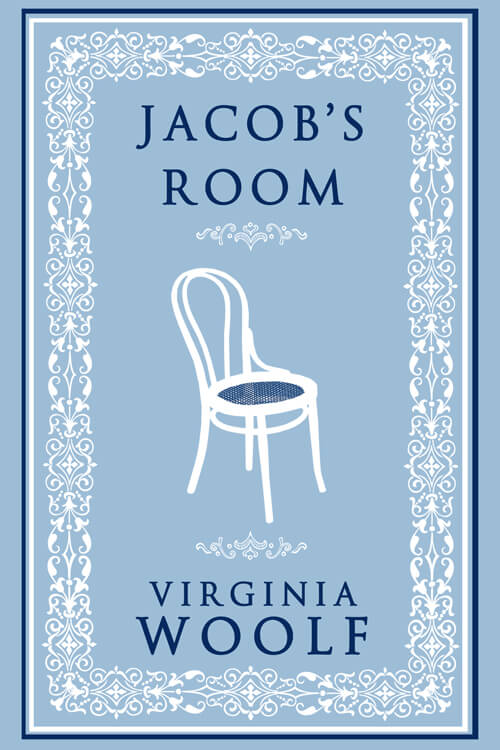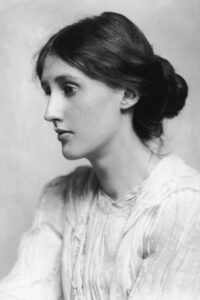
Jacob’s Room
“So, of course,” wrote Betty Flanders, pressing her heels more deeply in the sand, “there was nothing for it but to leave.”
Slowly welling from the point of her gold nib, pale blue ink dissolved the full stop; for there her pen stuck; her eyes fixed, and tears slowly filled them. The entire bay quivered; the lighthouse wobbled; and she had the illusion that the mast of Mr. Connor’s little yacht was bending like a wax candle in the sun. She winked quickly. Accidents were awful things. She winked again. The mast was straight; the waves were regular; the lighthouse was upright; but the blot had spread.
“…nothing for it but to leave,” she read.
“Well, if Jacob doesn’t want to play” (the shadow of Archer, her eldest son, fell across the notepaper and looked blue on the sand, and she felt chilly—it was the third of September already), “if Jacob doesn’t want to play”—what a horrid blot! It must be getting late.
“Where IS that tiresome little boy?” she said. “I don’t see him. Run and find him. Tell him to come at once.” “…but mercifully,” she scribbled, ignoring the full stop, “everything seems satisfactorily arranged, packed though we are like herrings in a barrel, and forced to stand the perambulator which the landlady quite naturally won’t allow….”
Such were Betty Flanders’s letters to Captain Barfoot—many-paged, tear-stained. Scarborough is seven hundred miles from Cornwall: Captain Barfoot is in Scarborough: and Seabrook is dead. Tears made all the dahlias in her garden undulate in red waves and flashed the glass house in her eyes, and spangled the kitchen with bright knives, and made Mrs. Jarvis, the rector’s wife, think at church, while the hymn-tune played and Mrs.
Flanders bent low over her little boys’ heads, that marriage is a fortress and widows stray solitary in the open fields, picking up stones, gleaning a few golden straws, lonely, unprotected, poor creatures. Mrs. Flanders had been a widow for these two years.
“Ja—cob! Ja—cob!” Archer shouted.
“Scarborough,” Mrs. Flanders wrote on the envelope, and dashed a bold line beneath; it was her native town; the hub of the universe. But a stamp? She ferreted in her bag; then held it up mouth downwards; then fumbled in her lap, all so vigorously that Charles Steele in the Panama hat suspended his paintbrush.
Read or download Book
Virginia Woolf
Adeline Virginia Woolf (25 January 1882 – 28 March 1941) was an English writer. She is considered one of the most important modernist 20th-century authors and a pioneer in the use of stream of consciousness as a narrative device.
Woolf was born into an affluent household in South Kensington, London, the seventh child of Julia Prinsep Jackson and Leslie Stephen in a blended family of eight that included the modernist painter Vanessa Bell. She was home-schooled in English classics and Victorian literature from a young age. From 1897 to 1901, she attended the Ladies’ Department of King’s College London, where she studied classics and history and came into contact with early reformers of women’s higher education and the women’s rights movement.
After her father died in 1904, the Stephen family moved from Kensington to the more bohemian Bloomsbury, where, in conjunction with the brothers’ intellectual friends, they formed the artistic and literary Bloomsbury Group. In 1912, she married Leonard Woolf, and in 1917, the couple founded the Hogarth Press, which published much of her work. They rented a home in Sussex and later moved there permanently in 1940.
Woolf began writing professionally in 1900. During the inter-war period, Woolf was an important part of London’s literary and artistic society. In 1915, she published her first novel, The Voyage Out, through her half-brother’s publishing house, Gerald Duckworth and Company. Her best-known works include the novels Mrs Dalloway (1925), To the Lighthouse (1927) and Orlando (1928). She is also known for her essays, such as A Room of One’s Own (1929).
Woolf became one of the central subjects of the 1970s movement of feminist criticism. Her works, translated into more than 50 languages, have attracted attention and widespread commentary for inspiring feminism. A large body of writing is dedicated to her life and work. She has been the subject of plays, novels, and films. Woolf is commemorated by statues, societies dedicated to her work, and a building at the University of London.
Work
Woolf is considered to be one of the more important 20th-century novelists. A modernist, she was one of the pioneers of using the stream of consciousness as a narrative device, alongside contemporaries such as Marcel Proust, Dorothy Richardson, and James Joyce. Woolf’s reputation was at its greatest during the 1930s, but declined considerably following the Second World War. The growth of feminist criticism in the 1970s helped re-establish her reputation.
Virginia submitted her first article in 1890, to a competition in Tit-Bits. Although it was rejected, this shipboard romance by the 8-year-old would presage her first novel 25 years later, as would contributions to the Hyde Park News, such as the model letter “to show young people the right way to express what is in their hearts”, a subtle commentary on her mother’s legendary matchmaking. She transitioned from juvenilia to professional journalism in 1904 at the age of 22. Violet Dickinson introduced her to Kathleen Lyttelton, the editor of the Women’s Supplement of The Guardian, a Church of England newspaper. Invited to submit a 1,500-word article, Virginia sent Lyttelton a review of William Dean Howells’ The Son of Royal Langbirth and an essay about her visit to Haworth that year, Haworth, November 1904. The review was published anonymously on 4 December, and the essay on the 21st. In 1905, Woolf began writing for The Times Literary Supplement.
Woolf would go on to publish novels and essays as a public intellectual to both critical and popular acclaim. Much of her work was self-published through the Hogarth Press. “Virginia Woolf’s peculiarities as a fiction writer have tended to obscure her central strength: she is arguably the major lyrical novelist in the English language. Her novels are highly experimental: a narrative, frequently uneventful and commonplace, is refracted—and sometimes almost dissolved—in the characters’ receptive consciousness. Intense lyricism and stylistic virtuosity fuse to create a world overabundant with auditory and visual impressions.” “The intensity of Virginia Woolf’s poetic vision elevates the ordinary, sometimes banal settings”—often wartime environments—” of most of her novels.”






